Different fire hose have different applications and maintenance requirements
Fire hoses are made with a specific use in mind, so it’s important to know the difference between them – including their materials and pressure tolerances – before making a purchase. Whether you are a part of a municipal fire-fighting team or you’re a building manager who needs new hose for a standpipe system, this article details the different uses and specifications of rubber coated, single jacket, and double jacket fire hoses – helping you determine which one is right for the job.
Before you choose a fire hose, there are some things to consider:
- What job do you need the hose to do?
- Does the National Fire Protection Association (NFPA) have codes or standards that determine which hose is used for a specific purpose?
- How difficult is the hose to maintain – and how long will it last?
If you already know the model you need, head straight to our selection. Otherwise, read on for a little fire hose 101.
Firefighters need attack hoses or supply hoses
A municipal fire department will typically not use the same hose to fight fires that someone would use in a residential emergency set-up that’s part of a standpipe system.
Attack hoses “are designed to be used by trained firefighters and fire brigade members to combat fire beyond the fire’s incipient, or initial, stage. This type of hose gets its name when used to ‘attack’ an outside fire or during initial structure breach.”
They must be able to deploy and withstand more pressure than other varieties – and be service tested to a minimum of 300 psi – so a more-durable hose is necessary for this application. Double-jacket hoses are designed to handle much higher pressures than their rubber-coated or single-jacket counterparts and therefore are best for attack uses.
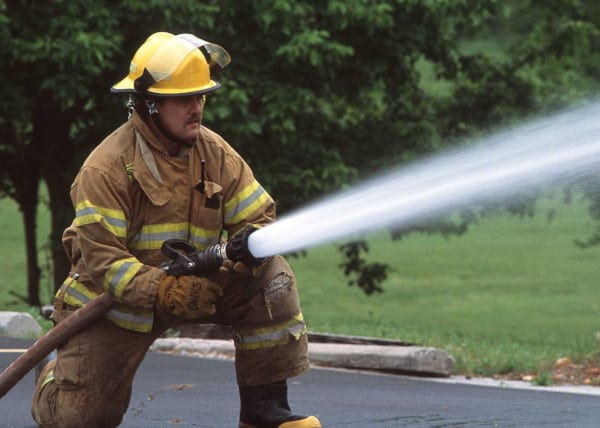
Supply hoses supply water from pressurized water sources to the fire pumps that feed an attack hose. They are usually rubber-coated hoses that range in size from 1.5 to 5 inches. The larger the diameter, the more gallons the hose can move per minute. Rubber-coated hoses are used as supply hoses since you want to move large amounts of water but do not need the hose to withstand high pressures.
NFPA 1962: Standard for the Care, Use, Inspection, Service Testing, and Replacement of Fire Hose, Couplings, Nozzles, and Fire Hose Appliances stipulates that “Hose marked SUPPLY HOSE shall not be used at operating pressures exceeding 185 psi” (4.1.10.1*), though some can tolerate more pressure.
To learn more about supply and attack lines, take a look our previous article: “Attack Line and Supply Hose: How to Source the Best Fire Hose.”
Building owners need an “occupant-use” fire hose for certain standpipe systems
A standpipe is a system of pipes that basically acts as a network of indoor fire hydrants. It allows occupants and/or firefighters to access water and fight fires in places where hose from a fire truck may not be able to readily reach. Marinas, boatyards, high-rise office buildings, apartments, hotels, and buildings with deep basements and/or helistops or heliports all require their installation.
There are three classes of standpipes:
- Class I standpipes can only be accessed by firefighters during an emergency and feature a 2.5” hose connection (though certain areas like New York and San Francisco use a special 3” connection). Firefighters must bring the hose to attach to these outlets.
- Class II standpipes feature onsite hoses that can be accessed by anyone in the event of a fire; these “occupant-use” hoses are attached to a 1.5” connection and are usually located in the hallways of older buildings.
- Class III standpipes are hybrids of class I and II standpipes. These typically have 1.5” and 2.5” hose connections with onsite hoses attached to the 1.5” connections. However, the connections and occupant-use hoses vary and may not be featured on every class III standpipe; there are versions of these systems that simply have a 2.5” connection, a reducer to a 1.5” connection, and no installed hose.
The hoses for these standpipes should comply with NFPA 14: Standard for the Installation of Standpipe and Hose Systems:
From the 2016 Edition of NFPA 14
4.6.2.1* Each hose connection provided for use by trained personnel (Class II and Class III systems) shall be equipped with not more than 100 ft (30.5 m) of listed, 11/2 in. (40 mm), lined, collapsible or noncollapsible fire hose attached and ready for use.
4.6.2.2 Where hose less than 11/2 in. (40 mm) is used for 11/2 in. (40 mm) hose stations in accordance with 5.3.2 and 5.3.3, listed noncollapsible hose shall be used.
QRFS offers lightweight rack and reel single jacket fire hoses that come pre-folded for ease of installation in a Class II or Class III standpipe.
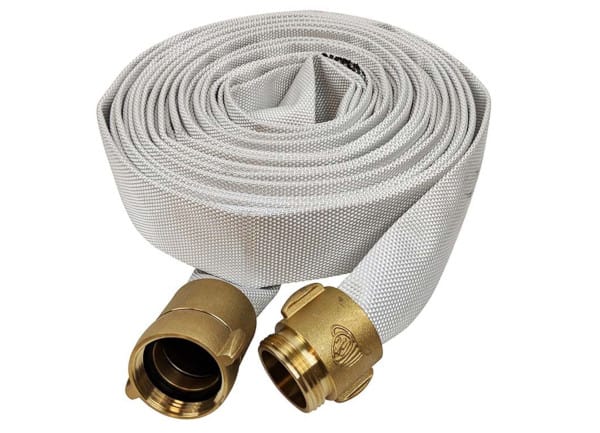
Note that installed rack and reel fire hose must be lined according to the Occupational Safety and Health Administration Standards for standpipes installed after January 1, 1981. Unlined fire hose should be replaced, as it cannot withstand high pressures and suffers too much friction loss, which causes rapid deterioration.
For much more information on standpipes, check out our previous series that starts with this piece: “Standpipe Systems (Part 1): Fire Protection Standpipe System Overview and Introduction to NFPA 14.”
Heavy duty fire hoses are needed in an industrial or construction environment
The exact type of fire hose used in these environments can vary depending on your needs. If you have to transfer water, you will want a hose that can move a large volume quickly. If you need to wash down big pieces of equipment, however, you will want a smaller hose that can supply significant pressure. Other individuals have used heavy-duty hoses in creative applications, such as one QRFS customer who uses pieces of our fire hose as a bladder system in their manufacturing equipment; and another who employs filled hoses as bumpers on boat docks.
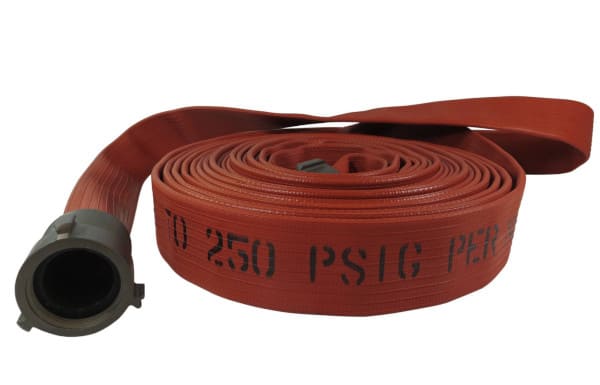
As mentioned above, supply line hoses are best for high-volume water transfer. If high pressure is not needed, a rubber coated supply hose with a large diameter would be the best fit for the job. You will want to choose a smaller, jacket-lined hose if more pressure is called for. A single jacket hose is often sufficient for these jobs, as they can withstand more pressure while striking a balance between durability and affordability. Again, a double-jacket hose should be used if the job requires more pressure than a single jacket hose can withstand.
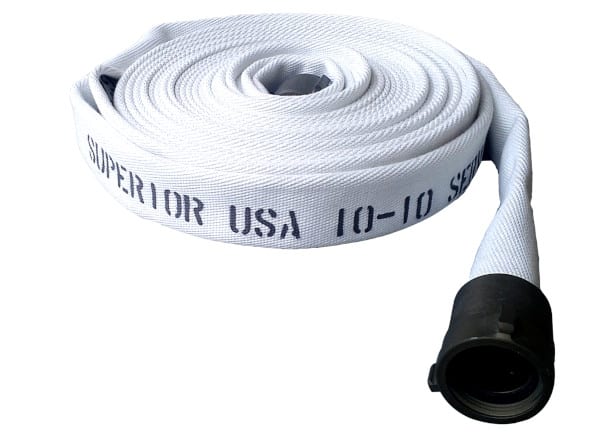
Fire hose weight is also a key consideration
A 1.5” hose is roughly the largest size that a single person can manage when the hose is fully charged, though a big, strong person might be able to handle 2”. Thus, if the application calls for an individual to direct the flow of water, smaller hose will be required; larger diameters are both very heavy and hard to control when filled. For an in-depth look at hose weight as well as more size and application considerations, check out our previous blog: “Double Jacket Fire Hose Comparison: 2 inch Fire Hose vs. 1¾ inch vs. 1½ inch.”
Fire hose materials
The rubber covered fire hoses from QRFS are manufactured from a synthetic nitrile rubber and are resistant to fuels, chemicals, oils, environmental pollutants, mold, mildew, and extreme temperatures.
Single jacket fire hoses have a layer of polyester “jacketed” around the interior rubber. The models available from QRFS are made from both staple and filament polyester, woven in both warp and weft direction. Warp fibers are lengthwise fibers that are stretched under tension, whereas weft fibers are woven crosswise under no tension to add strength and structure to the weave. The polyester itself as well as the weave are resistant to ozone, heat, and weathering.
Our double jacket fire hoses are also made from both staple and filament polyester, woven in both warp and weft direction. These hoses have more resistance to the elements than single jacket hose, as they have that extra layer of polyester jacket.
Fire hose maintenance: cleaning, testing, and storage
Fire hoses must be maintained – including proper cleaning, storage, testing, and inspection – to maximize their lifespan and ensure they work as intended.
Cleaning
Rubber coated fire hoses are designed for easy maintenance, as you can simply wipe down the hose to clean and dry it. Single and double jacket fire hoses require more attention to keep them in shape. These hoses should be cleaned with a soft to medium-bristled brush and mild soap to remove any dirt or debris. You can also use Denko hose cleaner concentrate (call us to order), which is expressly made for this purpose. After any scrubbing, hoses should then be rinsed and dried on a hose rack or dryer.
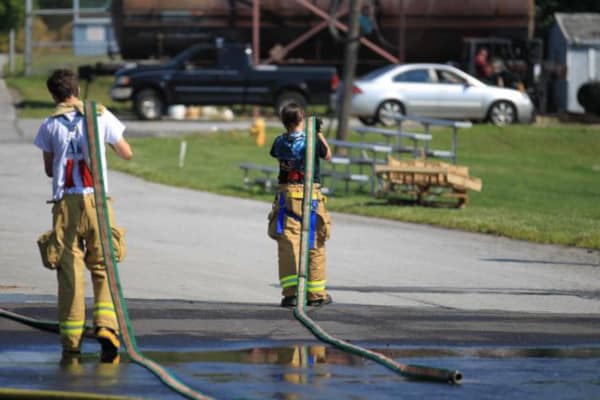
Testing
The service test pressures for supply and attack hoses, as well as occupant-use hoses installed on standpipes, are outlined in chapter 4 of NFPA 1962, which also specifies that any hoses “manufactured prior to July 1987 to meet the requirements of the 1979 and previous editions of NFPA 1961 shall be removed from service.”
From the 2018 edition of NFPA 1962
4.8.2.1 Attack fire hose shall be service tested to a minimum of 300 psi or a pressure not to exceed the service test pressure marked on the hose.
4.8.2.2 Supply fire hose shall be service tested to a minimum of 200 psi or a pressure not to exceed the service test pressure marked on the hose.
4.8.2.4 Occupant-use hose shall be service tested to the service test pressure marked on the hose.
NFPA 1962 specifies that attack and supply hoses that are in service shall be service tested as specified above at least annually (4.1.2*).
In contrast, standpipe hoses designed for occupant use shall be removed and service tested as specified above at intervals not exceeding 5 years after the date of manufacture and every 3 years thereafter to meet the NFPA 1962 standard (4.2.2).
Finally, any hoses that are held in storage for longer than one year shall be service tested as specified above before being placed into service (4.1.4).
Storage
The proper storage of fire hoses is outlined in section 4.7 of NFPA 1962:
4.7.1 Hose shall be kept out of direct sunlight and in a well-ventilated location.
4.7.2 All hose shall be drained and thoroughly dried before being placed in storage.
4.7.3 Hose shall be stored only after it has been inspected in accordance with Section 4.5 and has been cleaned and dried.
4.7.4 Hose that is out of service for repair shall be tagged as specified in 4.11.1.6 and 4.11.3.6 and kept separated from any hose in storage that is ready for service.
For more information on the proper care of fire hoses, please see our previous article: “Proper Cleaning, Use, Storage, Testing, and Inspection of Fire Hose.”
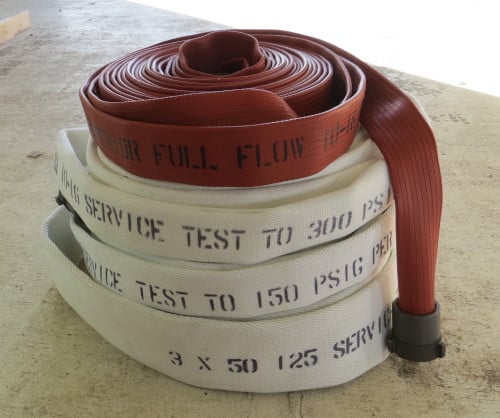
How long will each type of fire hose last?
There is no maximum lifespan of specific fire hoses, but over time the materials will degrade and they will need to be replaced. Proper care and testing will maximize the lifespan of your hose. Generally, a hose with more resistance to abrasion will last longer, but if a hose is not cared for properly the extra protection will not do much good.
Rubber coated fire hoses are designed to be resistant to many corrosive compounds as well as abrasions, and polyester jacketed hoses have this protection plus additional abrasion-resistance. You can also further protect certain non-lightweight fire hoses with Steadfast Coating. This optional coating is essentially another layer of rubber that is applied over the polyester jacket – it offers more abrasion and water resistance while maintaining the hose’s natural flexibility.
All the hoses offered at QRFS have a full 10-year warranty, ensuring that all models are free of defects in material and/or workmanship.
Our rubber-coated hoses are perfect for certain industrial and supply applications, along with our supply hoses expressly made for this purpose.
Single jacket fire hoses rated from 125 psi to 250 psi meet the needs of higher but still moderate pressure applications, such as hosing down equipment or for occupant use in standpipe systems.
Double-jacket hoses at 300 psi and 400 psi ratings are built to attack fires.
And a range of lightweight collapsible hoses are available for installation in your building’s Class II or Class III standpipe system.
Head to our product page to see our full selection of fire hoses. If you have questions, give us a call at 888.361.6662 or get in touch via our contact form.



NECESITO SABER SI USTEDES FABRICAN MANGUERA DE LONA DE 4-1/2 (CUATRO Y MEDIA ) PULGADAS
KEY – 02/11 SERVICE TEST TO 400 PSI PER NFPA MADE IN THE USA (ASÍ VIENE ESCRITO EN LA MANGUERA )
NECESITO SABER SI PODRÍA SER EN ROLLO DE 100 (CIEN ) METROS Y EL PRECIO TOTAL DE DICHO PRODUCTO, SI ES POSIBLE Y ME CONVIENE EL PRECIO ESTARÍA ORDENANDO 10 ROLLOS.
POR LA ATENCIÓN A LA PRESENTE Y ESPERANDO SU PRONTA RESPUESTA QUEDO MUY AGRADECIDO Y ESPERO PODER HACER NEGOCIO CON UDS
I NEED TO KNOW IF YOU MAKE 4-1 / 2 (FOUR AND A HALF) INCH CANVAS HOSE
KEY – 02/11 SERVICE TEST TO 400 PSI PER NFPA MADE IN THE USA (THIS IS WRITTEN ON THE HOSE)
I NEED TO KNOW IF IT COULD BE IN A ROLL OF 100 (ONE HUNDRED) METERS AND THE TOTAL PRICE OF SUCH PRODUCT, IF IT IS POSSIBLE AND IT SUITS ME, THE PRICE WOULD BE ORDERING 10 ROLLS.
FOR YOUR ATTENTION TO THE PRESENT AND WAITING FOR YOUR PROMPT RESPONSE I AM VERY GRATEFUL AND I HOPE TO BE ABLE TO DO BUSINESS WITH YOU
Thank you for reaching out. We will have someone from our QRFS Customer Support Team contact you, and you can also email any requests there to get faster service!
is it a necessity for the fire hose to be made of rubber for the hoses inside the buildings ? like is there a standered that says it must be made from rubber if you are using water ?
Abdulaziz — NFPA 1961: Standard on Fire Hose governs the materials and other requirements for fire hoses, including occupant-use hoses, and NFPA 14: Standard for the Installation of Standpipe and Hose Systems is also relevant (but references NFPA 1961). If you’d like us to research the exact materials requirements, you can try our Ask a Fire Pro service. Click the link to submit your questions, and a fire protection professional will provide an answer based on best practices, standards, and codes. Our pros include AHJs, contractors, engineers, and code experts with 150+ years of combined experience!